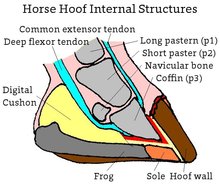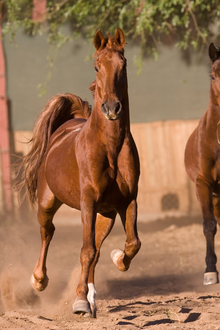Hoof care STARTS on the inside
At some point during the ownership of our horse companions, we either have a problem or face an injury. At that time we start on the path of gaining knowledge, as most of us truly want our horses to have a healthy and happy life. I actually feel that I have been fortunate that I have only had to become an “expert” in a couple of areas, and with Nan the issue has been her feet.
Hoof anatomy 101
The old saying “no hoof, no horse” has been around for many years and why it is truly applicable starts with understanding what a hoof is. So let's start with a little anatomy 101. Here is a diagram and an explanation to start the process:
The wall of the hoof is composed of a horny material that is produced continuously and must be worn off or trimmed off. The hoof wall does not contain blood vessels or nerves.

Internal horse hoof structure
The internal structure of the horse hoof dissipates shock and assists lower leg circulation.
© 2013 by Alex Brollo
In the front feet, the wall is thickest at the toe; in the hind feet the hoof wall is of a more uniform thickness. The wall, bars, and frog are the weight-bearing structures of the foot. Normally, the sole does not contact the ground.
Inside the hoof, lateral cartilage extend back and up from the inner and outer sides of the third phalanx. These cartilages are flexible, but as the horse ages they are usually ossified and replaced by bone.
Between the second and third phalanges and above the deep flexor muscle tendon is a small bone called the navicular bone. The navicular bone and its associated bursa, a fluid-filled sac that reduces friction between the tendon and the bone, is where navicular disease occurs and this causes lameness.
The digital cushion is a mass of flexible material that contributes to the formation of the heels. This structure is one of the primary shock absorbers of the foot. As weight is placed on the hoof, pressure is transmitted through the phalanges to the wall and onto the digital cushion and frog.
The frog, a highly elastic wedge-shaped mass, normally makes contact with the ground first. The frog presses up on the digital cushion, which flattens and is forced outward against the lateral cartilages. The frog also is flattened and tends to push the bars of the wall apart. When the foot is lifted, the frog and other flexible structures of the foot return to their original position.

Horses' hooves
Keeping your horse's feet healthy is the most important factor in reducing the chances of lameness.
When the foot is placed on the ground, blood is forced from the foot to the leg by the increase in pressure and by the change in shape of the digital cushion and the frog. The pressure and the change in shape compress the veins in the foot.
When the foot is lifted, the compression is relieved and blood flows into the veins again. In this way, the movement of these structures in the hoof acts as a pump. Exercise increases the blood circulation in the foot and favors good hoof growth. Lack of exercise, dryness of the horny wall, and poor nutrition inhibit hoof growth.
So ends the narrative of the anatomy of the hoof.
Back to Nan
You may remember me mentioning that Nan had an injury about four years ago. She was in the round pen with me working her and her hoof glanced off of a wooden panel and a 6-inch splinter was forced into her hoof wall via the coronet band.
It also nicked her artery in the hoof and I had about 10 minutes to get the trailer hitched and her in it and down the road to the vet, about 10 minutes away.
I was on the phone letting the vet know that I was flying in and they were ready for her. They stopped the flow of blood using a tourniquet.
They ended up having to section an enormous quarter off of her to flush the area of splinters in the hoof, and for months I had to clean and bandage the area.
Had I not done this, Nan would have been permanently lame and I probably would have had either chronic lameness issues or ended up having to make some other form of drastic decision (and yes, I have had that choice in other instances with Nan).
Since that time, I made the decision to go with barefoot trims for her. She is a horrid overreacher and routinely ripped shoes off of her front feet and NOTHING stopped it. I felt that we were just keeping her front hooves in a perpetual state of damage.
Then it became years of growing out the damage, and last year X-rays revealed that the injury had probably nicked her coffin bone as there was some remodeling that was showing up.
Your summer hoof care tips
Despite the cracking in the quarter that she repeatedly has as scar tissue, I have kept her sound. Some of this is due to constant vigilance to the following things, and these are your summer hoof care tips:
- I check her feet every morning when I feed her. I have a hoof pick hanging by her feed bucket and it is nothing to check them and pick them while she is eating.
- I keep her on Biotin supplements and I make sure that she is on a well-balanced feeding. Hoof care STARTS on the inside. I am rabid about the quality of her hay (ask my feed dealer).
- I rasp (mustang roll) her feet every single week. Yes, this is probably overkill, but it keeps her from flaring on her front feet, something she does consistently, and in this process I keep the “cracked scar” off of the ground by keeping it floated.
- Nan is ALWAYS ridden in hoof boots on her front feet. I have been through so many, but I have to tell you that I think I finally found a product that works, or maybe the hoof boots that fit her the best JUST came out on the market. I could have cried when I ordered them, put them on her, and rode her. They fit like a glove and she walked great in them.
In doing research I ran across a site for Keratex and read their article about hoof care and what they said makes a TON of sense.
Typically, we (horse owners) were under the impression that leaving mud slop around our tanks was the way to keep horses' hooves “wet” in summer and slopping on the oily nasty conditioners was the other way to go.
According to the makers of Keratex, both are BAD. Why?
Hooves are like fingernails - what happens when yours get wet? They get weak, and as for the oil substances, well, they mix with urine and turn into a water soluble liquid and wash right off into the dirt…. Again, this makes sense to me.
Another point they make is that modern bedding takes a wet hoof and super dries it, thus resulting in cracks. Their feeling is that straw is still the best bedding to use; other beddings stay wet and keep the hoof in a perpetual state of dampness, thus… weakening the hoof.
I am impressed enough with their logic and information that I am going to order a bottle of their gel and try it on Nan this year and see if it makes a difference. In the meantime, stay cool and Happy Trails to all.
